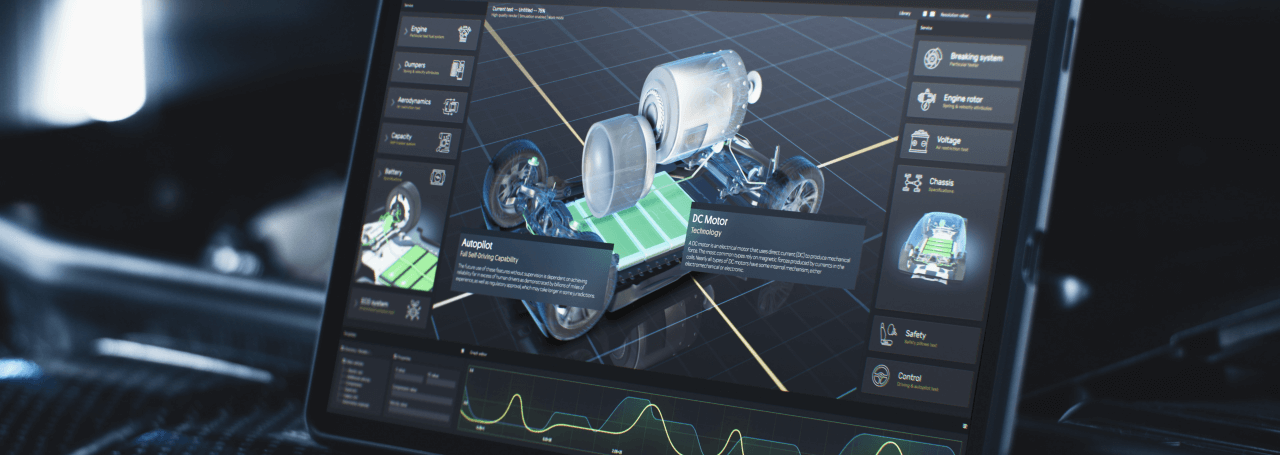- Why are STM32 Displays a breakthrough for engineers?
- Truly all-in-one: processing, memory, interfaces
- Rich interface options for industrial integration
- Dual-display capability via RiBUS
- Expandability and custom hardware support
- Power supply range and simplicity
- Inside the system: processing architecture
- Optimized memory configuration
- GUI design with TouchGFX
- Fast prototyping and development
- Summary: performance, simplicity, modularity
PART 1.
Deep dive into all-in-one display solution and easy GUI design tools
This article explores how the most powerful of Riverdi’s product series—STM32 Embedded Display—simplifies the development of modern HMI systems by combining a display, microcontroller, memory and interface support in a single compact module. Through practical examples and in-depth feature analysis, you’ll learn how engineers can reduce system complexity, accelerate GUI development and integrate powerful STM32 functionality directly into their devices.
Topic covered:
- What makes STM32 Embedded Displays truly “all-in-one” solution
- Interface and expansion capabilities for embedded applications
- How to drive two displays using a single system
- Memory configuration for graphics-rich UIs
- GUI creation using ST’s TouchGFX framework
Why are STM32 Displays a breakthrough for engineers?
As modern embedded systems demand greater and greater integration as well as performance, Riverdi introduces its most advanced display series to date—the STM32 Embedded Displays. Spanning sizes from 5.0 to 12.1 inches, these intelligent displays go far beyond traditional HMI solutions by incorporating a powerful microcontroller directly on the display’s PCB—STM32H757XIH6 for 7”, 10.1” and 12.1”, and STM32U5G9 for 5” display. This design turns each unit into a fully capable embedded computer.
Such an “all-in-one” architecture eliminates the need for an external host system. In earlier display modules, such as those based on EVE technology, an external processor was required to manage logic, send commands to the screen and control the application flow. In contrast, STM32 Embedded Displays handle the entire process internally. The onboard microcontroller executes the full application logic, manages user interfaces, and coordinates I/O operations — all from within the display module itself.
This approach significantly simplifies the design of embedded devices. Whether it’s a coffee machine, a medical instrument, an EV charging station or an industrial control unit, the display can serve as the system’s central processing unit. Engineers and project managers can focus entirely on their application, while relying on STM32 display to manage both visualization and control.
Truly all-in-one: processing, memory, interfaces
The STM32 Embedded Displays are designed as fully self-contained computing platforms. Onboard components include:
- STM32 microcontroller—from the high-performance STM32H7 series, featuring dual-core architecture (Cortex-M7 + Cortex-M4).
- RAM and Flash memory—both internal (2 MB flash + fast internal RAM) and external (8 MB SDRAM, 64 MB QSPI flash).
- Multimedia storage—capable of storing rich graphics, video files, and UI assets locally.
The entire system operates independently—in the demo showcasing the display’s capabilities, the only external connection is a single power cable. All image rendering and application execution is done directly on the display itself.
Rich interface options for industrial integration
From the engineering perspective, the back side of the STM32 Embedded Displays reveals their versatility. Designed with system integrators and product designers in mind, these displays offer a comprehensive set of interfaces that enable flexible communication, control and expansion.


Starting from one side of the board, we find RS-485 — a powerful, differential interface widely used in industrial automation, capable of supporting MODBUS and other serial protocols. Right next to it is RS-232, a standard serial connection, slightly different but similar in functionality, ideal for legacy or simple device communications.
Next to the serial interfaces are three onboard buttons: two configurable user buttons and one reset button, useful during development and debugging. A power diode indicator provides clear visual feedback when the system is powered.
Larger STM32 models (7″, 10.1″, and 12.1″) are equipped with dual CAN interfaces, allowing communication with CAN-enabled devices or subsystems—a crucial feature in automotive, industrial and energy sectors.
For user feedback applications, there is a dedicated haptic interface, enabling the connection of vibration motors to provide mechanical feedback on touch interactions — particularly useful in public terminals or tactile-rich UI designs.


The system is also modular: an add-on connector enables attachment of an Ethernet module, available as an accessory from Riverdi. This module supports PoE (Power over Ethernet), allowing both power and data to be delivered via a single cable — an especially valuable feature in networked environments where minimizing cabling is essential.
There is also a battery holder for an RTC (Real-Time Clock), ensuring accurate timekeeping even during deep sleep modes or power outages. This is crucial in data logging, scheduling, and timestamping operations.
A dedicated SWD (Serial Wire Debug) interface is available for low-level programming and debugging of the STM32 microcontroller. While intended for developers, this interface ensures full access to the chip during both prototyping and maintenance.
Internally, the display panel is connected via LVDS (Low Voltage Differential Signaling), offering high-speed data transfer to the integrated screen without external wiring.
Dual-display capability via RiBUS
The RiBUS interface provides a practical solution for applications requiring two displays. Originally developed for Riverdi’s EVE-series displays, RiBUS is fully compatible across product lines and now functions as a host interface on the STM32 Embedded Display series.
Using RiBUS, engineers can connect a second display—such as an EVE4—directly to the primary STM32 display, forming a dual-screen configuration powered by a single STM32 microcontroller. This setup eliminates the need for a second processor, reducing both complexity and cost.
The main STM32 display handles the user interface and application logic using the TouchGFX graphics library. The secondary EVE4 display receives visual data through RiBUS, acting as a smart output device.
Common use cases include:
- POS terminals:
one display facing the cashier (e.g. control interface), the other facing the customer (transaction details). - Coffee or vending machines:
one screen for interactive selection, another for dynamic content like brewing videos or advertisements.
This configuration allows for a richer user experience while maintaining a unified control system. RiBUS ensures that both displays remain synchronized and responsive, without the expenses of dual-host coordination.
Watch the EVE4 and STM32 displays video playback capabilities.
Read a short guide on how to connect displays using RiBUS.
Expandability and custom hardware support
To support project-specific needs, Riverdi provides an extension connector with access to unused STM32 pins. Developers can mount and connect their own expansion boards directly to the display PCB using pre-defined standoffs located near the interface.
The extension connector exposes a wide variety of signal types, making it possible to connect additional functional modules.
Possible add-ons include
- GPS or GNSS modules—for geolocation and navigation tasks.
- Wi-Fi, GSM, or LoRa modules—for wireless communication and remote connectivity.
- Digital and analog I/O modules—for sensing, control and automation tasks.
These interfaces include I2C, SPI, USB, and analog GPIOs, giving developers full flexibility in expanding the functionality of the display. This makes the system highly adaptable to both prototyping and production stages.
The layout is designed with practicality in mind: modules can be physically secured to the display using standard screws and spacers, enabling mechanically stable integration of daughter boards directly onto the HMI hardware. This modularity ensures that even highly customized solutions remain easy to achieve and maintain.
Power supply range and simplicity
The STM32 Embedded Displays support a broad input voltage range—from 6 V to 48 V—enabling direct integration into systems with variable or unregulated power sources, including industrial, automotive and energy systems.
This flexibility removes the need for external voltage regulation or conversion circuits, simplifying the system design and improving reliability in electrically noisy environments.


The main power connector is a standard Molex-style socket, ensuring reliable and secure power delivery. For added convenience, an optional PoE (Power over Ethernet) 802.3at Type 2 „PoE+” module is available. With this connection, a single Ethernet cable can supply both power and communication, completely simplifying installation. Additionally, STM32 offers a place for a RTC (Real-Time Clock) battery, enabling the display to go into the deep sleep mode with the clock still running.
Inside the system: processing architecture
At the heart of Riverdi’s 7″, 10.1″, and 12.1″ STM32 Embedded Displays lies the STM32H7 microcontroller, one of the most powerful MCUs available in ST’s portfolio. It features a dual-core architecture consisting of:
- Cortex-M7 core—responsible for high-performance computing, including graphics processing and data-intensive tasks. It handles the majority of display rendering and application execution when performance is critical.
- Cortex-M4 core—optimized for low-power, real-time control tasks. It can remain active independently of the M7, enabling background operations, peripheral management or maintaining device state during display sleep modes.
Such an architecture offers a strategic energy advantage—the system can slow down to the M4 core during inactive periods, reducing power consumption without halting system responsiveness. For example, a vending machine could continue its operations or communicate with sensors even while the user interface is temporarily blank.
Optimized memory configuration
The STM32 system includes a well-balanced memory setup, optimized for responsive, media-rich interfaces:
- Internal Flash Memory (2 MB)—used for storing the main application code, ensuring fast access and execution.
- Internal RAM—for real-time processing and short-term variable handling.
- External SDRAM (8 MB)—designed for advanced graphical use cases. It supports multiple frame buffers (double or triple buffering), enabling smooth image transitions and fast refresh rates—even for video playback.
- External QSPI Flash (64 MB)—provides suitable space for media assets such as GUI layouts, images, fonts, icons and video sequences.
- MicroSD card slot—available for additional memory expansion or dynamic content updates in the field. For example, UI elements, promotional videos or multilingual resources can be updated without reflashing the main firmware.
The combination of memory types ensures both high-speed execution and sufficient capacity for complex multimedia applications.


GUI design with TouchGFX
Riverdi’s STM32 Embedded Displays are tightly integrated with TouchGFX, a graphics library developed and maintained by STMicroelectronics. It allows engineers to create modern, responsive and animated graphical user interfaces with minimal effort.
TouchGFX is:
- Completely free of charge for all STM32 users
- Designed for resource-constrained embedded systems
- Highly optimized for hardware acceleration and minimal memory usage
As an ST Authorized Partner, Riverdi ensures that its hardware is fully compatible and officially supported in the TouchGFX ecosystem.
Watch the video or read the article on how to get started with STM32 and TouchGFX free library.
Fast prototyping and development
Developing a UI with TouchGFX is efficient and beginner-friendly. Engineers can download the TouchGFX Designer, a visual application builder, and begin designing UIs with drag-and-drop tools.
Riverdi displays are already integrated as predefined hardware targets within the builder—listed alongside ST’s own Discovery boards. This allows immediate access to:
- Ready-to-use project templates
- Preconfigured resolution and memory settings
- Example interfaces and demos
With these tools, the engineer can:
- Skip low-level configuration
- Focus directly on UI logic and layout
- Flash the application directly to a STM32 display with minimal setup
In practice, a fully functional smart home interface — as demonstrated in Riverdi’s demo — can be developed, compiled, and running on hardware in a matter of hours.
This level of integration shortens development cycles and lowers the entry barrier for teams transitioning from traditional MCU UI development to modern, touch-capable systems.
Learn how to design your Riverdi GUI design with TouchGFX designer here.
Summary: performance, simplicity, modularity
Riverdi’s STM32 Embedded Displays combine display technology, embedded processing, memory and connectivity into a compact and highly configurable module. With powerful dual-core processing, memory architecture, comprehensive interface suite and built-in support for TouchGFX, these display series offer a complete foundation for building next-generation HMI systems.
Whether for industrial automation, smart home or professional instrumentation—STM32 Embedded Displays are engineered to simplify your project management and development as well as to accelerate time-to-market.
Getting started with the STM32 family?
Check out the tutorial on how to get started with the example of 5” display.
CHECK OUT RIVERDI’S IMPLEMENTATION-READY PRODUCTS
Be sure to find the right industrial-grade display for your device:
- Need to enhance the brightness and optical performance of your display? Choose High Brightness IPS Displays with optical bonding that perfectly reduce the reflection and correct contrast.
- In search of the most effective data interchange between graphics and a truly industrial touch controller? Check BT817Q (EVE 4) product category with revolutionary communication protocol for industrial, medical and military applications requiring beautiful and sophisticated GUI.
- Looking for one of the highest resolution (1280×800 pixel) HMI displays based on STM32H7 MCUs? Choose STM32 Embedded Displays with high performance enabled by STM32H757XIH6 (2MB Flash, 1MB RAM) microcontroller.
- Need a plug and play HDMI interface and USB-C touch solution? Pick the HDMI Displays that are high-resolution, high-brightness IPS TFT products with optical bonding and industrial grade touch screen as Riverdi’s standard.
CONTACT US
Contact our expert to dive deeper into display implementation for your project.
Having issues with your current technology? Want to learn about frameworks and our clients’ success stories? We are happy to discuss and assist you with your design and R&D challenges.
DISCOVER OUR
Whitepaper
Achieve the perfect user-display interaction with the right Touch Sensor IC. Ever faced issues with phantom touch events or certification? Boost your R&D like a pro with our Whitepaper!







